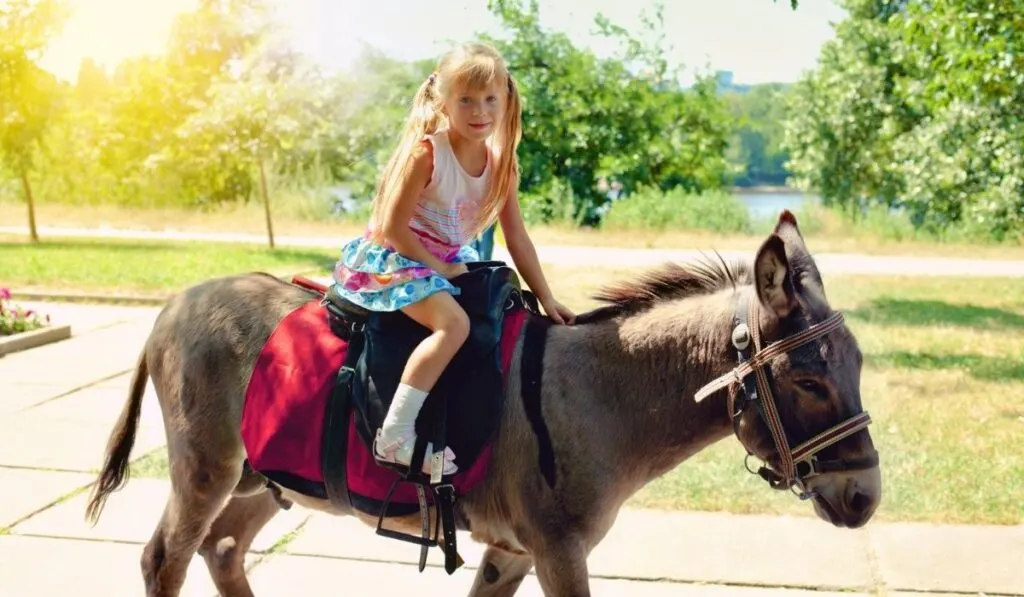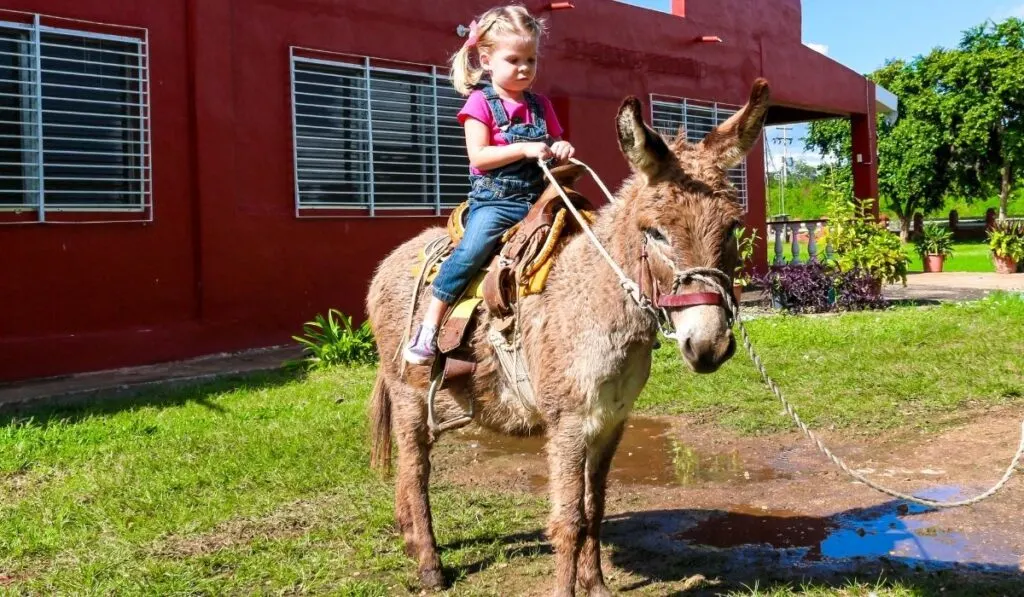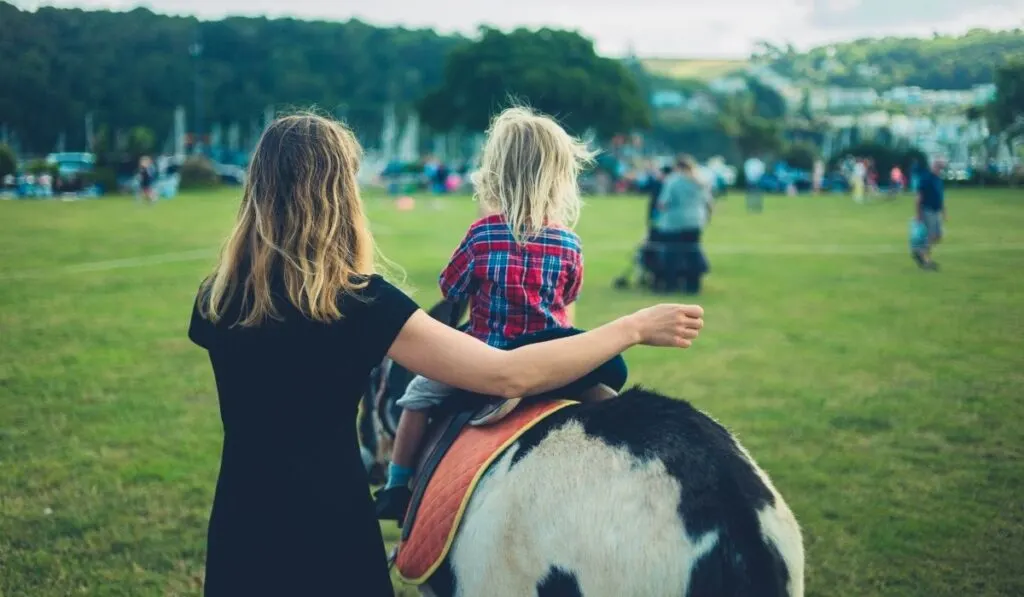Donkeys are a popular animal on many farms, however, they’re not the first animal you probably think of when discussing rideability. The fact is, some donkeys can be ridden and they may even be easier to train than some horses.
You can ride a donkey if it is properly trained and large enough to carry you safely without causing stress or injury to them.
There are several steps you can follow to teach your donkey how to be ridden. Sometimes, though, despite your best efforts, some simply do not want to be ridden.
Donkeys need to be trained to ride before you attempt riding them. With a little patience and the right training, you can teach most donkeys to ride safely.
There are a few things you need to learn about donkeys and their rideability before you follow our step-by-step guide to teach your donkey to ride.
Table of Contents
Can You Ride a Donkey?
You can ride a donkey that is able to carry your weight easily and that has been properly taught to ride. Lucky for you, donkeys come in a variety of sizes, so finding one that you can ride should not be a problem.
It is also vital that the donkey you intend to ride has been properly taught how to be ridden. You cannot ride a donkey that has not had any training; it may end badly for both you and the donkey.
While donkeys often excel at being ridden once they are trained, they are not born with the ability or the desire to have a person just hop on their backs. An untrained donkey usually does not respond well to having a person try to climb onto them.
At What Age Can Donkeys Be Ridden?
Donkeys can be ridden when they are mature which does not occur until they are at least four years old; some donkey experts suggest waiting even longer.
Riders often begin working with donkeys on ground manners at a younger age, however, donkeys should not be ridden before at least four years old.
Training should begin as early as possible to get the basics down and make sure the donkey is comfortable being handled often by humans. Foundation training, which involves learning ground manners, takes lots of time and consistency.
Donkeys should not be ridden by a person until they are fully grown and have been properly and successfully trained by an experienced rider.
How Much Weight Can Donkeys Handle?
Donkeys are a lot like horses in this department in that they can only carry about 20% of their own weight. This means that a 600-pound donkey can only carry about 120 pounds safely.
A donkey’s weight can vary depending on what category of donkey they belong to. In the United States, donkeys are categorized by size, not by breed, since most of them are descendants of multiple breeds.
Donkeys in this country are either miniature, standard, or mammoth-sized. Miniature donkeys weigh up to 400 pounds, standards weigh between 400 and 900 pounds, and mammoth donkeys weigh up to 1300 pounds.
Is a Jenny, Jack, or Gelded Donkey Best For Riding?
Gelded male donkeys are best for riding because they are typically the easiest to train and the less likely to act out during a ride. Gelding simply means that the donkey has been castrated to prevent breeding and reduce male hormones, both of which make the donkey easier to handle.
A Jenny, a female donkey, is the second-best option for riding, although special care needs to be taken during heats. They are not always as docile as gelded male donkeys, but they can be trained to ride.
Intact male donkeys, called Jacks, are not ideal for riding because they are harder to train and harder to handle. It is not recommended to attempt to train an intact, stud donkey to ride.
Equipment Needed
There are several things you will need if you intend to teach your donkey how to be ridden. Here is the most important equipment you will need to teach a horse to ride.
Safe Riding Area
You will need to have a safe arena, riding paddock, or pen of some kind to train your donkey in. It is not recommended to teach your donkey to ride in a large paddock or pasture.
This riding area should be fully enclosed so that the donkey cannot run too far if it gets away from you. It should not be so small, however, that it frightens the donkey.

Donkey-Friendly Riding Tack and Accessories
You need to locate all the riding tack you will need including a halter, bridle, bit, reins, saddle, saddle pads, girth, breastplate, and tie-down. More often than not, these items can be difficult to find in your donkey’s unique size.
Most of these accessories are made for horses, so you will need to take measurements and test each item out to see if it really fits. You may even need to search online for tack made especially for donkeys, especially bridles.
Grooming Tools
If you intend to ride a donkey, it will need to be used to being groomed and handled regularly. You should have a hoof pick, hoof brush, body brush, and a comb to start with.
Regular grooming will keep your donkey healthy and get them used to being handled. The last thing you want is a donkey that you can ride but you cannot brush its mane or clean out its hooves.
How to Train a Donkey to Ride
1. Build a solid and trusting foundation.
You cannot successfully train a donkey to ride if there is no solid and trusting foundation already established. Work with your donkey in the months prior to teaching it to ride to build a relationship with it.
Your donkey should be comfortable wearing a halter and should be used to being led around on a lead rope without any issues before you even begin teaching it to ride.
2. Familiarize the donkey with the riding equipment.
A donkey will learn best when you are patient and allow it to get used to things at its own pace. Take time to introduce it to the bridle, reins, and saddle pads slowly; save the saddle for a later time.
If the donkey acts frightened, step back and allow it to get over its fear. Do not force anything on a donkey if it is not being receptive.
Introduce varying amounts of weight slowly.
Get the donkey used to carrying progressively heavier amounts of weight on its back before putting the saddle on. If the donkey has never carried anything, it will not be very thrilled about having something on its back for the first time.
Start small and increase the weight slowly so the donkey feels comfortable. Once it is used to carrying the same weight as the saddle, it will be time to introduce the saddle.
4. Introduce the saddle to the donkey slowly.
You should introduce the saddle to the donkey slowly, allowing it to see, smell, and get comfortable just seeing it. Once it appears comfortable being around the saddle, you can attempt to place it and the saddle pads on the donkey’s back.
It may take multiple attempts and training sessions to get the saddle on the donkey and even more before you can even tighten it.
5. Lead the donkey around with just the saddle and saddle pad on its back.
With a lead rope and halter, lead the donkey around the pen with the saddle and saddle pad on its back. It will need to get familiar with carrying the saddle for a long time before it can handle carrying a human.
6. Teach the donkey the commands you intend to use while riding.
As you lead the donkey around with the saddle, go ahead and start using the verbal commands you want the donkey to respond to. When you begin riding, your donkey will better understand these verbal cues.
The more your donkey knows going into training, the better it will respond.
7. Introduce the donkey to the bit and bridle you plan to use.
Finding the right bit and bridle for your donkey is difficult, but introducing them to the donkey does not have to be that hard. Take your time and allow your donkey to familiarize itself with the unfamiliar tack.
Once the donkey is calm, patiently try to put the bridle and bit on the animal. Again, this may take multiple attempts and it should not be forced.
Choosing the right bit sometimes takes a little trial and error, but snaffle bits seem to be a popular choice when it comes to donkeys. You may even need to opt for a pony size if you are working with a mini or small standard donkey.
8. Allow the donkey to get used to the full tack outfit before riding.
Once the donkey is comfortable with the bit and bridle, start leading it around the pen with all the tack you intend to use when riding. The donkey should be extremely comfortable with the whole setup before being ridden.
You really do not want to throw too much at the donkey at one time when it comes to teaching it how to ride. All of these steps may seem like it draws out the whole ordeal, but in reality, it just makes everything go a lot smoother.

9. Introduce human weight to the donkey.
Now that the donkey is used to all the tack, familiar with verbal commands, and comfortable around you, the first introduction to being ridden can commence. Make sure the donkey can comfortably and safely handle the weight of the person that plans to ride it.
The rider should pay close attention to cues from the donkey that may indicate that it is not comfortable or not ready to be ridden.
The saddle should be tightened securely and the rider should mount the donkey slowly. The first few attempts at mounting the donkey’s back may be rough, but with time and patience, the donkey should get comfortable.
10. Be consistent with riding and stay calm throughout the process.
The keys to teaching a donkey to ride are to stay consistent and to stay calm, even if you are nervous. Stick with the same commands you taught the donkey during your groundwork training and try to have training sessions daily if possible.
The more often the donkey is ridden, the more comfortable it will become with the whole situation. Taking long breaks in between sessions can result in regressive behavior causing you to have to start all over.
Donkeys are a lot like horses in that they can sense when you are fearful or not comfortable. They also do not respond well to anger, yelling, or quick movements.
11. Start with the basics and stay patient.
Teach your donkey the simple things first, like walking, turning, stopping, and backing up. If it balks at something, do not get aggressive, simply try again with a firm, but gentle hand.
It may seem repetitive at this point, but donkeys do not respond well to aggression or forceful behavior. If they are frightened, donkeys will often respond defensively.
Walking fast and running can all be learned as time progresses. You do not want to teach a donkey to run unless you know you can get it to stop easily.
12. Branch out when comfortable.
When you feel completely comfortable riding your donkey in an enclosure, you can attempt to branch out to an empty pasture or paddock setting. The goal is to open the area but maintain an enclosed space in case of unforeseen issues.
Use the opportunity to introduce the donkey to more open areas to see how it responds. Take your time, make sure someone is with you or nearby, and stay calm.
Before you even consider taking the donkey for a ride off the farm, make sure you are comfortable riding it everywhere on your own farm.

Things To Keep In Mind
Pay attention for signs of distress during training.
If the donkey is limping, it may have hoof issues, or the weight it is carrying is too much.
If it is not responding well to the bit or bridle, make sure nothing on the donkey’s face is being pinched or injured by the tack.
If needed, have a veterinarian check out the donkey if you notice any issues that need to be addressed.
Always have someone with you during training sessions.
Even the most experienced equestrians should have someone nearby when riding for safety measures. Accidents can happen anytime you are around a donkey.
Have a vet look over the donkey before training.
It is recommended to have a vet or at least an experienced equestrian check over the donkey before you start teaching it to ride. They will be able to identify any physical or health issues that need to be addressed prior to riding.
If the donkey is a male, make sure it has been gelded.
Intact male donkeys are simply too unpredictable to teach to ride. It is best to work with a gelded male donkey or a female jenny donkey when it comes to riding.
Do not feel ashamed if you need to call in a professional trainer.
Even experienced equestrians balk at the idea of teaching a donkey to ride and often turn to professionals for help.
Teaching a donkey to ride involves a lot of time, repetition, and patience. It is understandable if it is just too much or if you simply want a professional to give you a few pointers.
Final Thoughts
Now you know that most donkeys can be ridden with the right training, yet not every donkey can be ridden by every person. Minis and small standard donkeys are best for kids while large standard and mammoth donkeys are ideal for average-sized adults.
With these steps, you have learned here and a little persistence, you may just be able to train your own donkey to ride.
Resources:
Researching the rideability of donkeys and how to teach them to ride was an adventure in itself. Here are the sources used in the writing of this article.
- https://donkeywise.org/donkey-info/donkey-training/
- https://donkeywise.org/donkey-info/about-donkeys/

